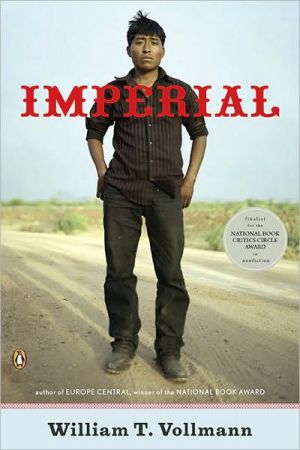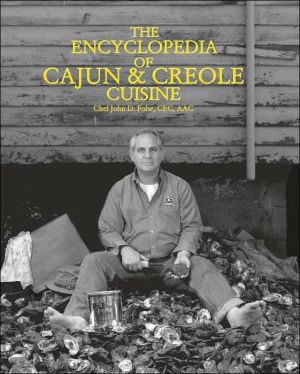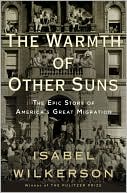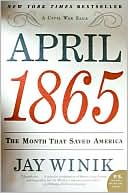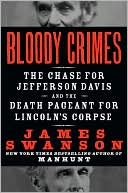Imperial
"It sprawls across a stinking accidental sea, across the deserts, date groves, and labor camps of southeastern California, right across the Mexican border. For generations of migrant workers, from Okies fleeing the Dust Bowl of the 1930s to Mexican laborers today, Imperial County has held the promise of paradise - and the reality of hell. It is a land beautiful and harsh, enticing and deadly, rich in history and heartbreak. Across the border, the desert is the same but there are different...
Search in google:
An epic study of an emblematic American region by one of our most celebrated writersIt sprawls across a stinking artificial sea, across the deserts, date groves, and labor camps of southeastern California, right across the Mexican border. For generations of migrant workers, from Okies fleeing the Dust Bowl of the 1930s to Mexican laborers today, Imperial County has held the promise of paradise-and the reality of hell. It is a land beautiful and harsh, enticing and deadly, rich in history and heartbreak. Across the border, the desert is the same but there are different secrets. In Imperial, award-winning writer William T. Vollmann takes us deep into the heart of this haunted region, and by extension into the dark soul of American imperialism.Known for his penetrating meditations on poverty and violence, Vollmann has spent ten years doggedly investigating every facet of this bi-national locus, raiding archives, exploring polluted rivers, guarded factories, and Chinese tunnels, talking with everyone from farmers to border patrolmen in his search for the fading American dream and its Mexican equivalent. The result is a majestic book that addresses current debates on immigration, agribusiness, and corporate exploitation, issues that will define America's identity in the twenty-first century. The Barnes & Noble Review Imperial County, in the southeastern corner of California, seems at first glance like an improbable subject for a 1,125-page work of nonfiction. Imperial is known for its winter lettuce, its "Sweet Imperial" onions, and the Salton Sea, a polluted saline lake it shares with Riverside; otherwise, it's the kind of landscape where there's so little going on that the Navy uses a great swath of it as an air-to-ground gunnery range. Imperial has played the Kuwaiti desert (in Jarhead) and the desert planet Tatooine in Star Wars. Even the county's Chamber of Commerce can muster only a few facts about it: the county was established in 1907; its highest point is Blue Angel Peak (4,548 feet), its lowest the Salton Sea (a paradoxical 235 feet below sea level). How much, you have to wonder, can there be to say about Imperial?
\ Justin MoyerAn aborted novel transformed into nonfiction that is simultaneously tedious, exhilarating, dry and heartbreaking, Imperial thrives on its smart design (historical documents and Vollmann's own striking photographs break up the immense narrative) and its author's awareness that he can't quite understand his chosen subject…"Imperial does not need me to be itself," Vollmann insists, but no one who reads this singular, significant book—half Michael Harrington's The Other America, half James Joyce's Finnegans Wake—will contemplate NAFTA, illegal immigration or a trip to a "Southside" brothel without thinking of him.\ —The Washington Post\ \ \ \ \ Publishers WeeklySignatureReviewed byMichael CoffeyThis is an exasperating, maddening, exhausting and inchorent book by the stunningly prolific Vollmann, who has really outdone himself. Eleven hundred pages plus endless endnotes about a single county in California is as perverse as Vollmann has dared be-which is saying a lot for a guy who has written a massive collection of tales about skinheads (Rainbow Stories), a sevenvolume history of the settling of a measly continent (Seven Dreams) and another seven volumes on the history of violence (Rising Up and Rising Down). But a big book about one county? Well, it's not just any county. Imperial is the southeasternmost county in California, bordering with Mexico to the south and Arizona to the east, across the Colorado River. Is it a place deserving of this seemingly disproportionate chronicle? Today, it is a hot spot for illegal immigration, law enforcement action, drug trafficking, prostitution and sweatshop labor in maquilladoras, fetid border factories. It is a place, sure enough, where imperialism has made its mark. Over the past centuries, a lot of bad things have happened in El Centro, as the region is also called, and very little good, as Vollmann's excessive datadump demonstrates ad nauseam. The Spanish came, murdered, plundered, left; America annexed; land grabs ensued and Colorado River water was illegally diverted westward to render a temporary agricultural paradise and make a few fortunes. As with most of his books, Vollmann has performed mindboggling feats of research, gobbling up obscure and arcane texts about the Spanish conquests, hydrography, citrus cultivation,immigration, poverty rates, desalinization, drug use, human smuggling and exploitation of the weak by the wealthy in all its guises as it applies to this benighted, once beautiful desert region. If Vollmann has a point of view here, an axe to grind, it is that he is appalled by the power inequities and the subsequent suffering of the Mexicans, and he is moved by the latter's simple desire to have a better life. But gouts of a bleeding heart make for some viscous prose, and, as seldom happens with Vollmann, his emotions overcome his cool and his positions fray into incoherence. Vollmann's normally reliable narrative voice veers between tour guide-speak and backpacking sociologist, with the occasional lyrical paean to a lady of the night. As a result, Imperial County is a place that few will have the stomach to visit, and Imperial a book few will be willing to read. (powerHouse is publishing a book of 200 photographs Vollmann took during the course of his research: $55 [200p] ISBN 9781576874899.) Photos, maps. (Aug.)Coffey is executive managing editor atPW.Copyright © Reed Business Information, a division of Reed Elsevier Inc. All rights reserved.\ \ \ Library JournalAward-winning writer Vollmann (Europe Central) spent more than ten years researching Imperial County, CA, and the result is this complex, detailed, but often frenetic look at Southern California's border region. Vollmann uses Imperial's history to explore larger issues, such as immigration policies. Unfortunately, it appears that Vollman wanted to include every nugget of information he discovered-every interesting anecdote, roadside sign, or newspaper advertisement-and cram it all into this book, with the rationale for arrangement mostly unclear and with no synthesis or analysis (though plenty of his own bias). For example, he includes a series of hand-drawn maps at the beginning but waits until the final pages to explain them and put them into context. In addition, at least 12 different font types and sizes were used throughout, which only proves distracting. Overall, this book suffers under its own weight-it comes in at over 1300 pages, and evidently no index is planned. Perhaps Vollmann's accompanying photo book, to be published simultaneously by powerHouse (not seen by reviewer), would be a better purchase for interested libraries. Not recommended, though Vollmann fans will still ask.\ —Mike Miller\ \ \ \ \ \ Kirkus ReviewsVollmann (Riding Toward Everywhere, 2008, etc.) has yet to meet a subject he cannot convert into a tome to rival the Manhattan phone book. So it is with this long, strange trip through California's Imperial County. "At four-thirty in the morning the air smells sulphurous and sweet like Karachi, and a bird sings." Readers sensitive to the possibilities of poetry in prose will value a book, no matter how long, that contains that line. Those who value honesty in reportage will admire Vollmann's admissions of time voluntarily spent among drifters, meth-heads and demimondaines: "Only now do I feel capable of writing novels about American street prostitutes, with whom I have associated for two decades." Readers who seek a view of the U.S.-Mexico border beyond talking-head banalities will smile at subheads such as "A Clarification About Whiteness" and "My First Tunnel." Vollmann's latest doorstopper has endless moments of virtuosity and points of interest, and even if there are limits to patience-one senses that Vollmann prizes extra-long books as a means not of overwhelming the reader but because he lacks a shutoff valve-his book captures perfectly the sun-stricken, toxic landscapes of inland Southern California. This is a place far from the beaches, Mediterranean villas and tony restaurants on the coast, a place of astounding pollution, horrific smells (of which Vollmann provides a Homeric catalog) and hundreds of ways to die (ditto, most featuring drugs, cars and bad guys). Why do people go there, then? They're mesmerized, perhaps, as Vollmann clearly is, by the unlikely possibilities of a place such as Duroville, a collection of broken trailers on the shores of the fetid Salton Sea, orMexicali, where Chinese keep portraits of the Virgin of Guadalupe on their walls and so outnumbered Mexicans that they were once outlawed. Magnificent, impressive and utterly unique. A word to anyone seeking to follow Vollmann's path, however: Get your gamma globulin shots, and write shorter.\ \ \ \ \ The Barnes & Noble ReviewImperial County, in the southeastern corner of California, seems at first glance like an improbable subject for a 1,125-page work of nonfiction. Imperial is known for its winter lettuce, its "Sweet Imperial" onions, and the Salton Sea, a polluted saline lake it shares with Riverside; otherwise, it's the kind of landscape where there's so little going on that the Navy uses a great swath of it as an air-to-ground gunnery range. Imperial has played the Kuwaiti desert (in Jarhead) and the desert planet Tatooine in Star Wars. Even the county's Chamber of Commerce can muster only a few facts about it: the county was established in 1907; its highest point is Blue Angel Peak (4,548 feet), its lowest the Salton Sea (a paradoxical 235 feet below sea level). How much, you have to wonder, can there be to say about Imperial? \ But William T. Vollmann -- whose novel Europe Central won the National Book Award in 2005 -- finds plenty. What begins as a simple "attempt at delineation" grows and grows, until it comes to resemble that map Jorge Luis Borges wrote about, "a Map of the Empire whose size was that of the Empire, and which coincided point for point with it." There are reasons for this. For one thing, no county exists in a vacuum, least of all Imperial: receiving as it does less than three inches of rain a year, its agriculture depends entirely on water from the Colorado River, which it shares uneasily with its neighbors. It borders on Mexico, and so is caught up in the politics and economics of immigration. Even its name once applied to a larger region, the Imperial Valley, which descends southward with the river to the Gulf of California.\ So the story of a county becomes the story of a river, which becomes the story of all the interests that have, over the years, fought to appropriate it. The desert blooms with farms, and the farms need cheap labor; the Mexicans who are trucked in to work the harvest want to settle in the United States, and mechanisms are devised for keeping them out. Imperial is emblematic of a practice that might charitably be called capitalism, but which in fact seems more like a malign symbiosis of public dollars and private interests. First the Colorado River was dammed and its water largely legislated out of Mexican hands; then the industrialization of agriculture drove out the small producers; now the cities buy water rights from the farmers, who can make more money by selling their (subsidized) water and letting their land lie fallow. It's not an entirely new story -- Joan Didion has told it before, and so has Mike Davis, and so has Chinatown -- but Vollmann's version of it, which relies heavily on reported speech, newspaper clippings, interpolations from a never-written novel called Imperial, and so on, has a vastness that is less reminiscent of Didion or Davis than it is of Dos Passos' U.S.A. trilogy. The book is boundless, grasping, in a word, imperial.\ A map the size of the terrain is a poor aid to navigation, and the danger of a work with these dimensions is that the reader will get lost. Imperial has 208 chapters, but I would be hard pressed to tell you what any one of them (with a few notable exceptions) is about. Like a traveler going in circles in the desert, the narration returns again and again to the same phrases, which seem a little more bitter and empty with each go-round: "The desert disappears," "We need have no fear that our lands will not become better and better as the years go by," "I have never been cheated out of a dollar in my life." Have I passed that cactus before? Three hundred and fifty pages in, we get a chapter on a woman named Imperial Hazel Deed, whose name supposedly emblematizes the settlers' pride; then we learn that her name was actually just Hazel Deed. Seven hundred and thirty-five pages in, Vollmann sums up Imperial's problems in a six-paragraph "Excerpt from a Report." Its first sentence is "Imperial is TOO HOT." It seems possible that the author, too, has contracted a mild case of sunstroke.\ In this featureless terrain, a handful of landmarks rise up: the story of Vollmann's trips down the foul R?o Nuevo, a river of sewage that runs from an undisclosed location south of the border to the Salton Sea; a fascinating hundred pages on the "Chinese tunnels" reputed to exist under the city of Mexicali; a grimly funny account of Vollmann's attempts to infiltrate the maquiladoras of Tijuana with the help of a couple of private detectives, a woman named Perla, and a "button camera." Most of these episodes began as magazine articles, and in them we get a glimpse of Vollmann the journalist: conscientious, dogged, and not easily embarrassed, he goes from setback to setback, arriving at a story that is rarely as sensational as it might have been in the hands of another writer but makes you feel as if you've actually seen something of the world.\ In one of the most moving of these sections, Vollmann tells the story of a woman he once loved. He visited Imperial County in her company, and he writes,\ It was because she took such pleasure in Imperial that I began to write this book. In my mind's sad confusion after she was gone, I could not distinguish, much less define, any Imperial which did not include her.\ Here delineation fails; the lunar (or Tatooine-ish) landscape of Imperial is also the desolation of heartbreak. It's a promising way to understand what Imperial is up to -- if our narrator is going in circles, perhaps it's because he's looking for a landmark that is no longer anywhere to be found? -- but ultimately Vollmann's book is too big to be reduced to the drama of a single heart. The heartbreak is general; it belongs to the small farmers who were edged out by the big ones, to the real estate agents still trying to sell new custom homes on the shores of the reeking Salton Sea, to the pollos drowning in the All-American Canal, to the maquiladora workers with their persistent coughs. Unless more fresh water can be found somewhere, one day it may belong to everyone. --Paul La Farge\ Paul La Farge is the author of two novels: The Artist of the Missing and Haussmann, or the Distinction.\ \ \
